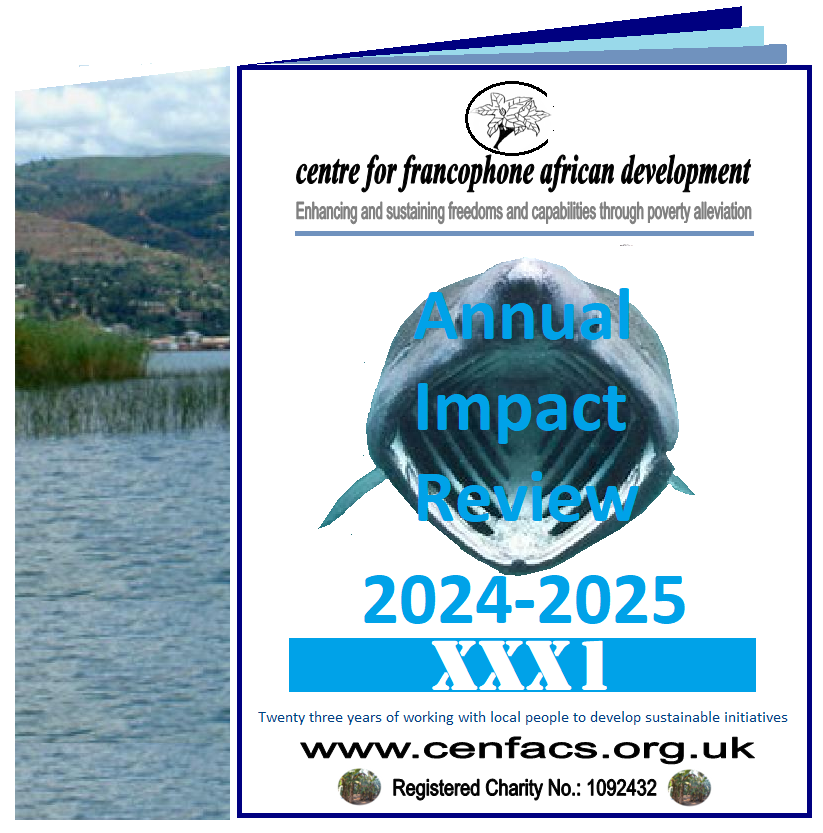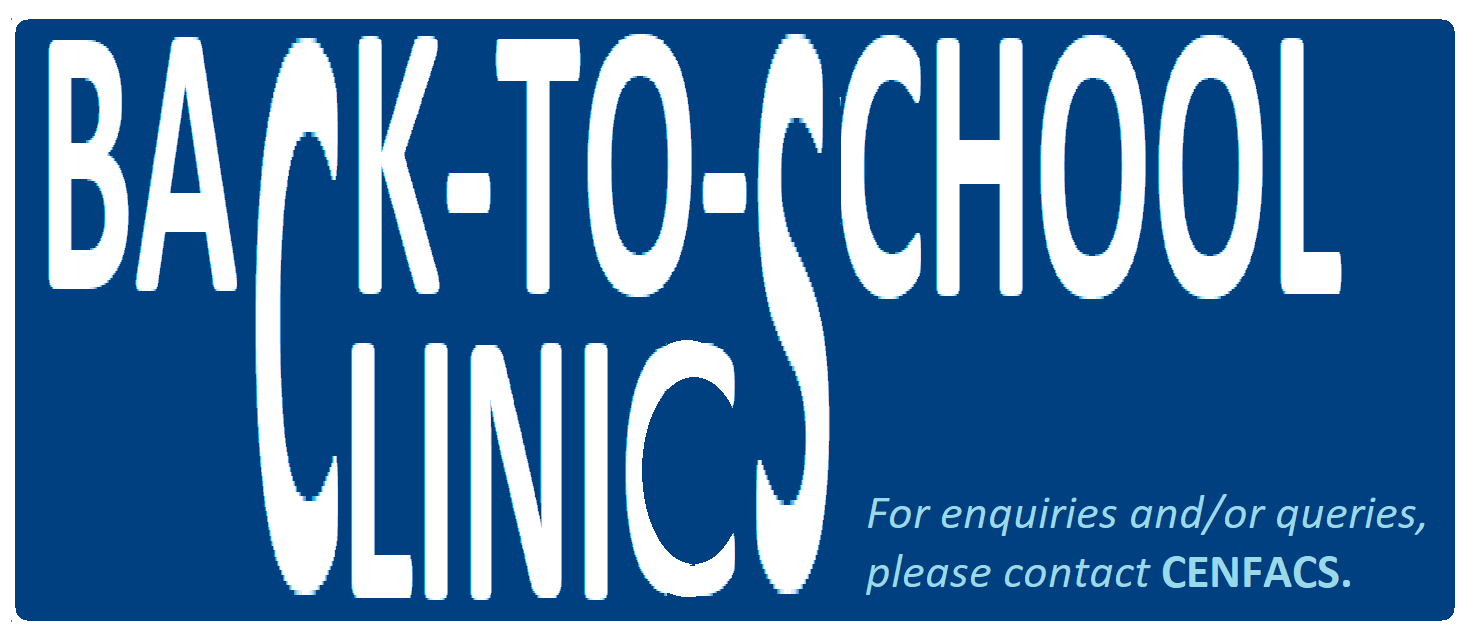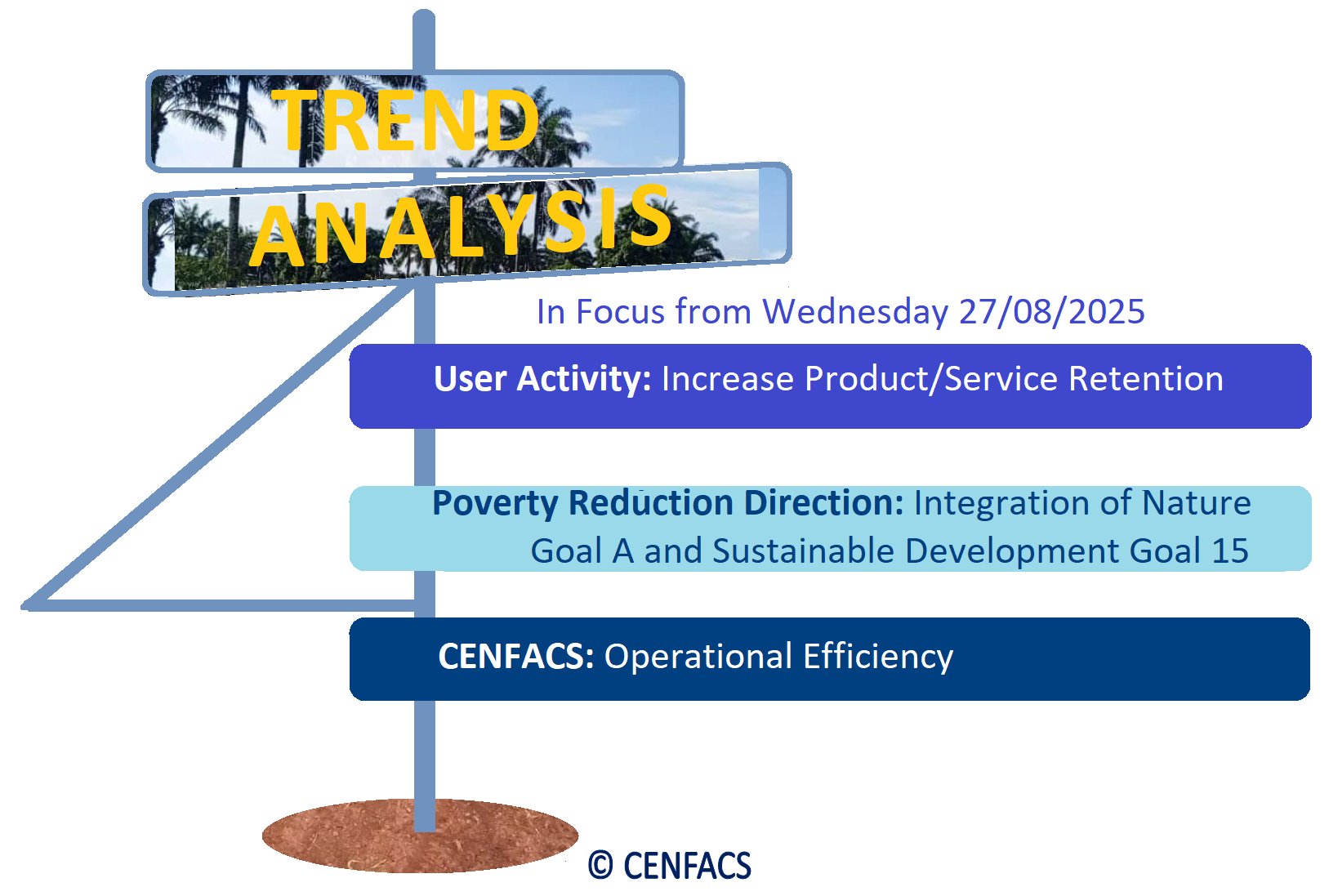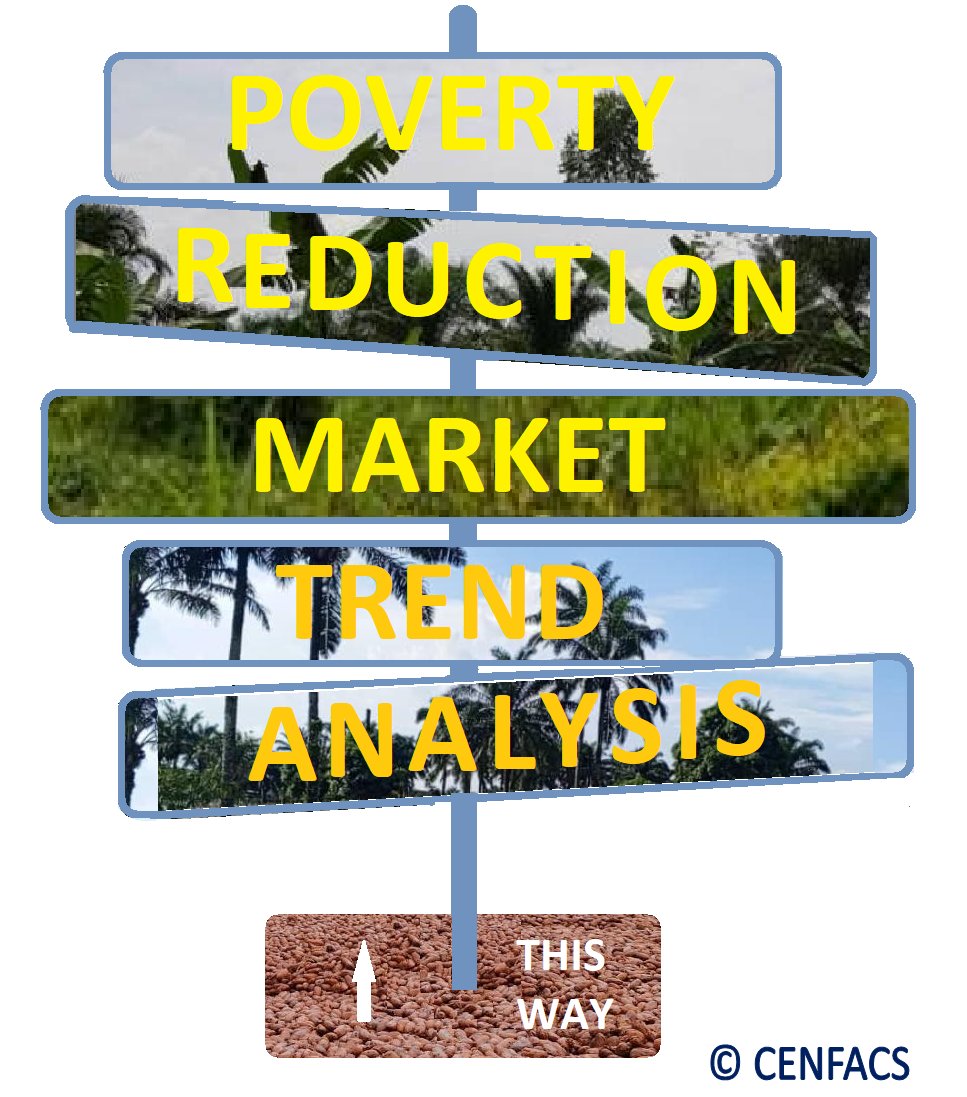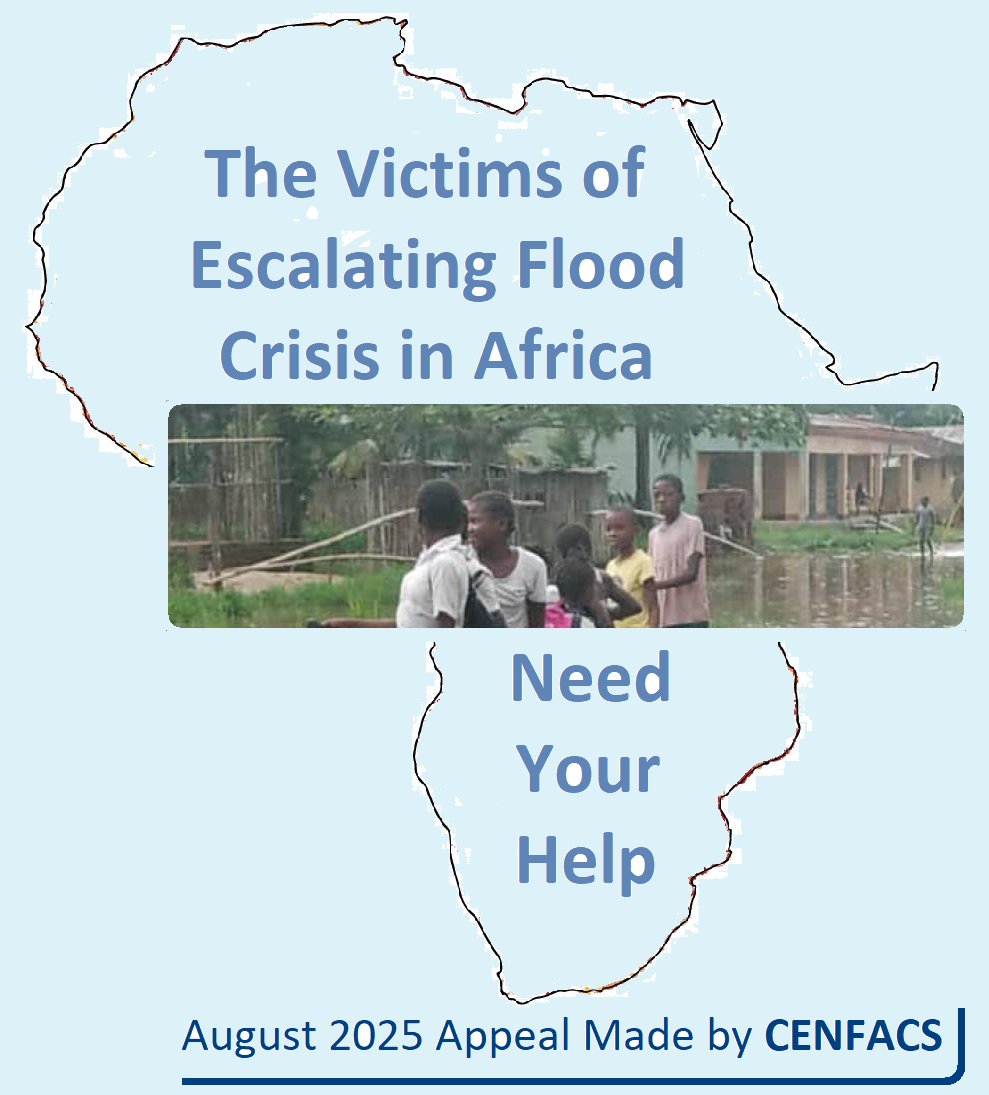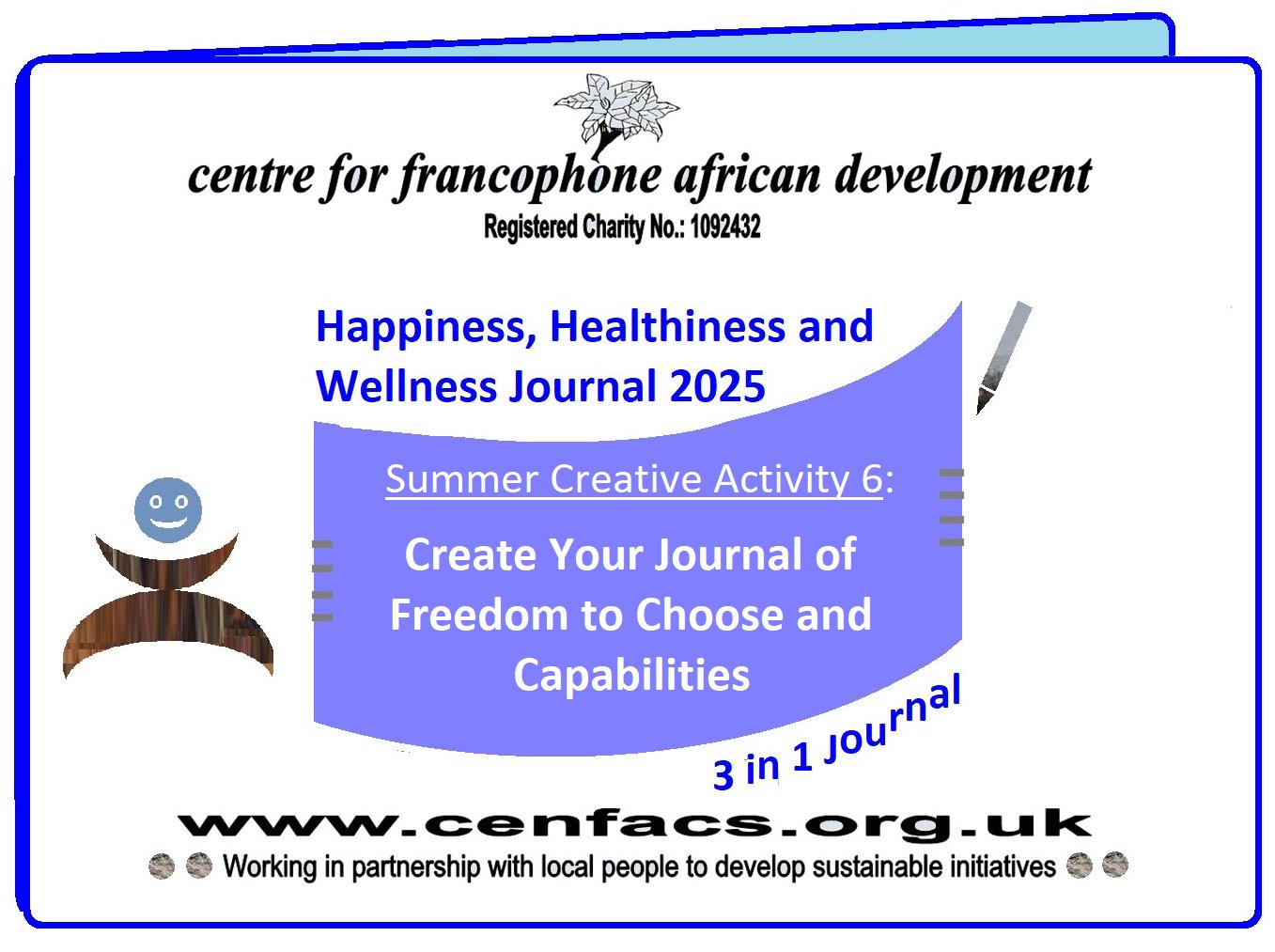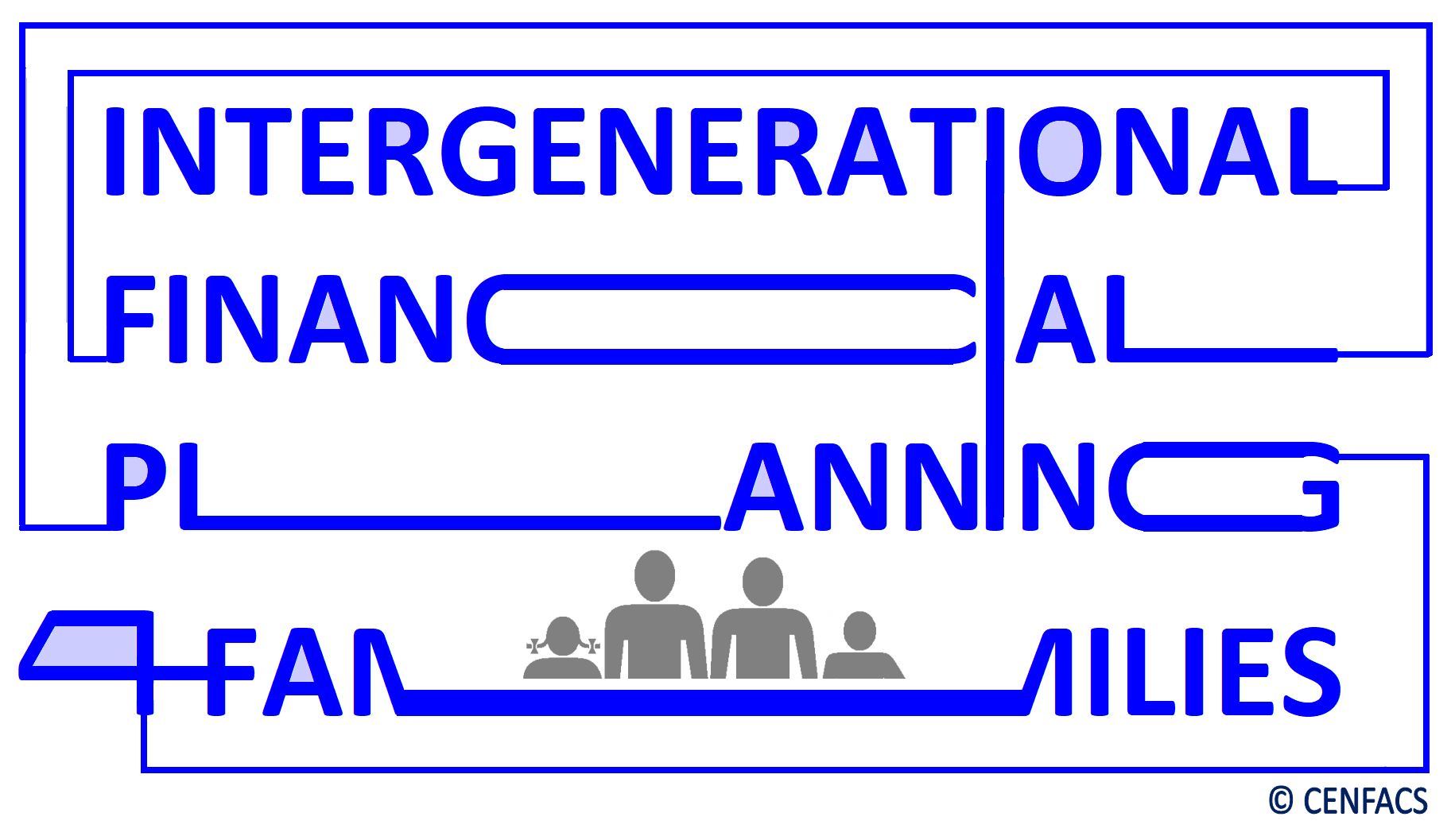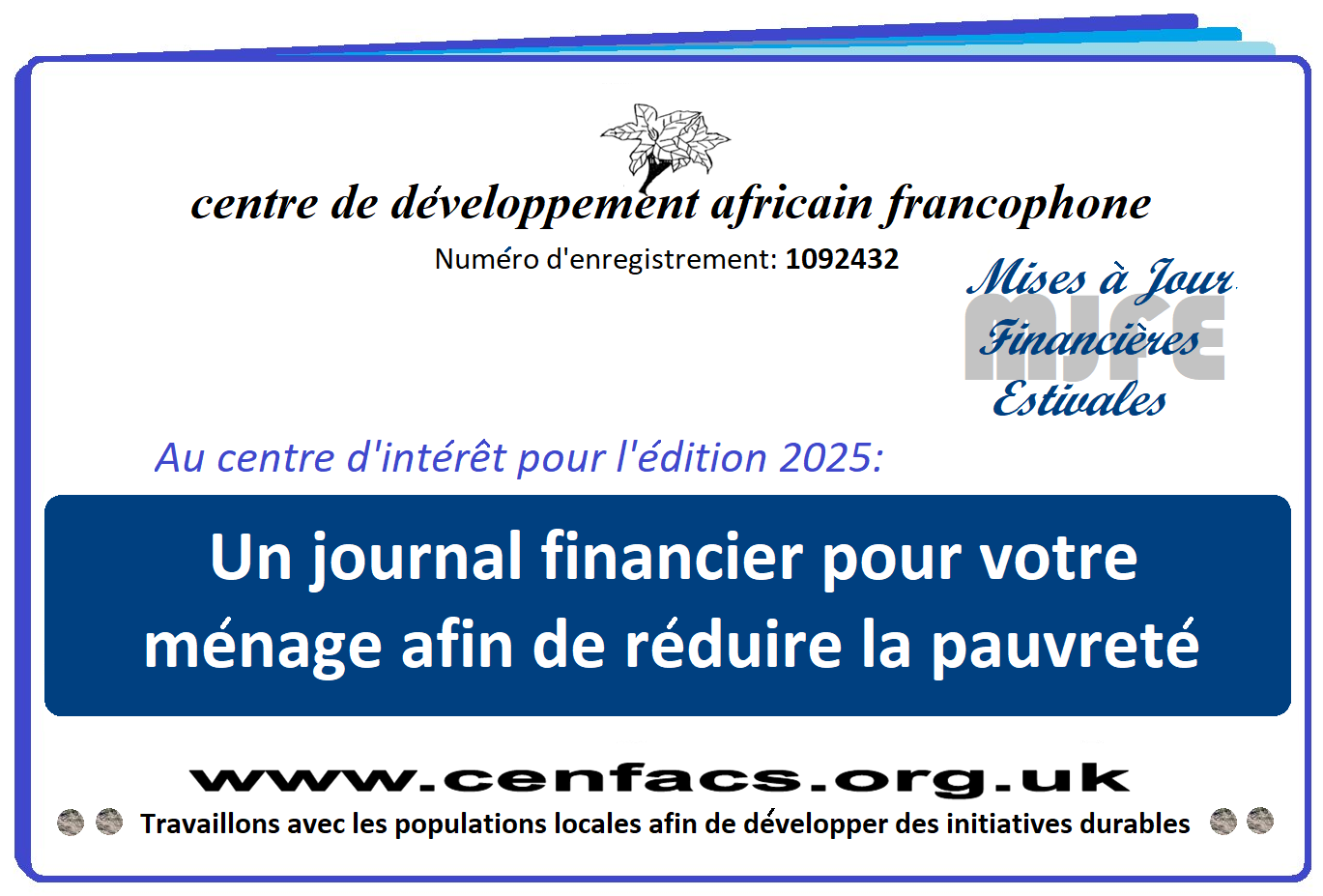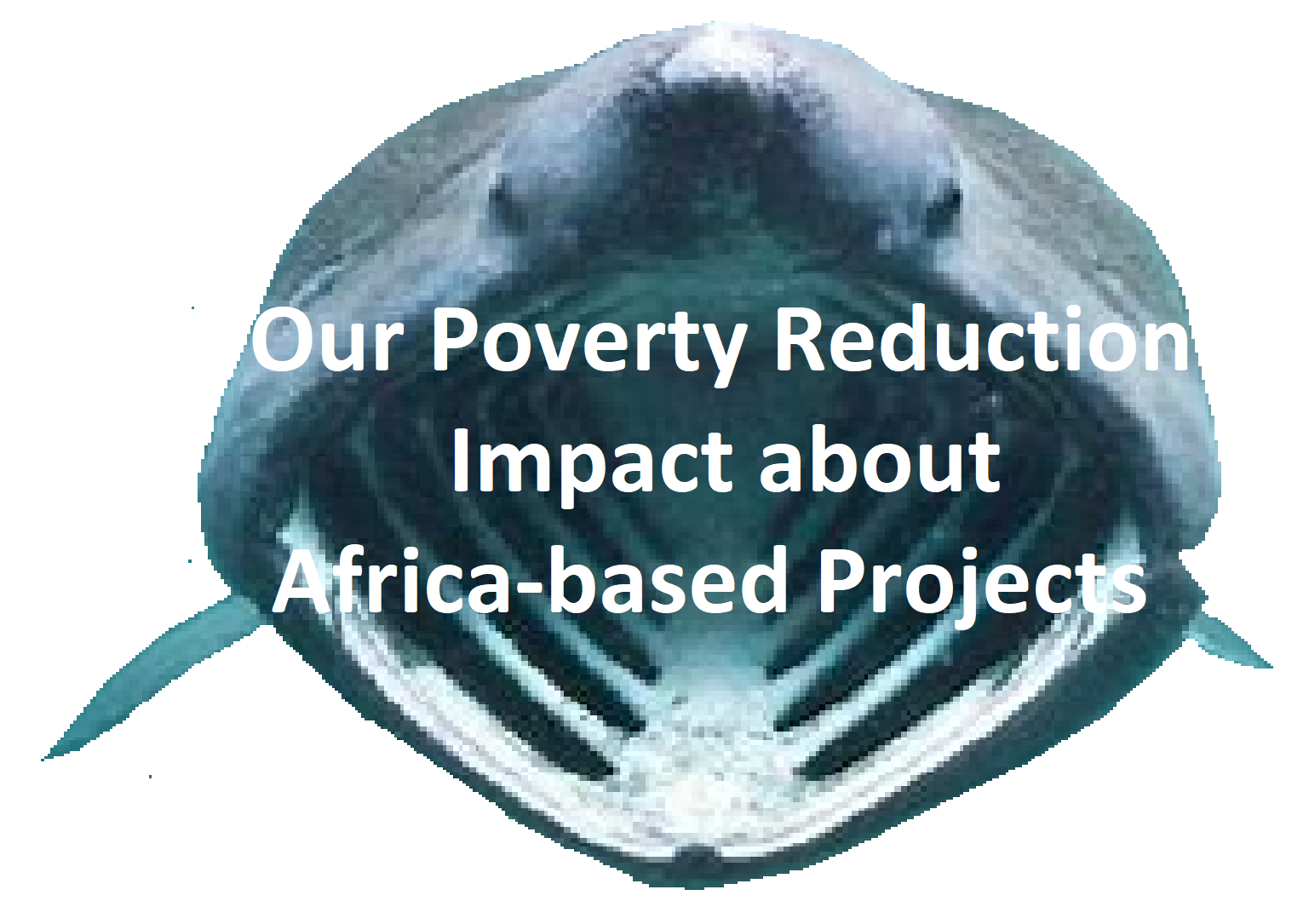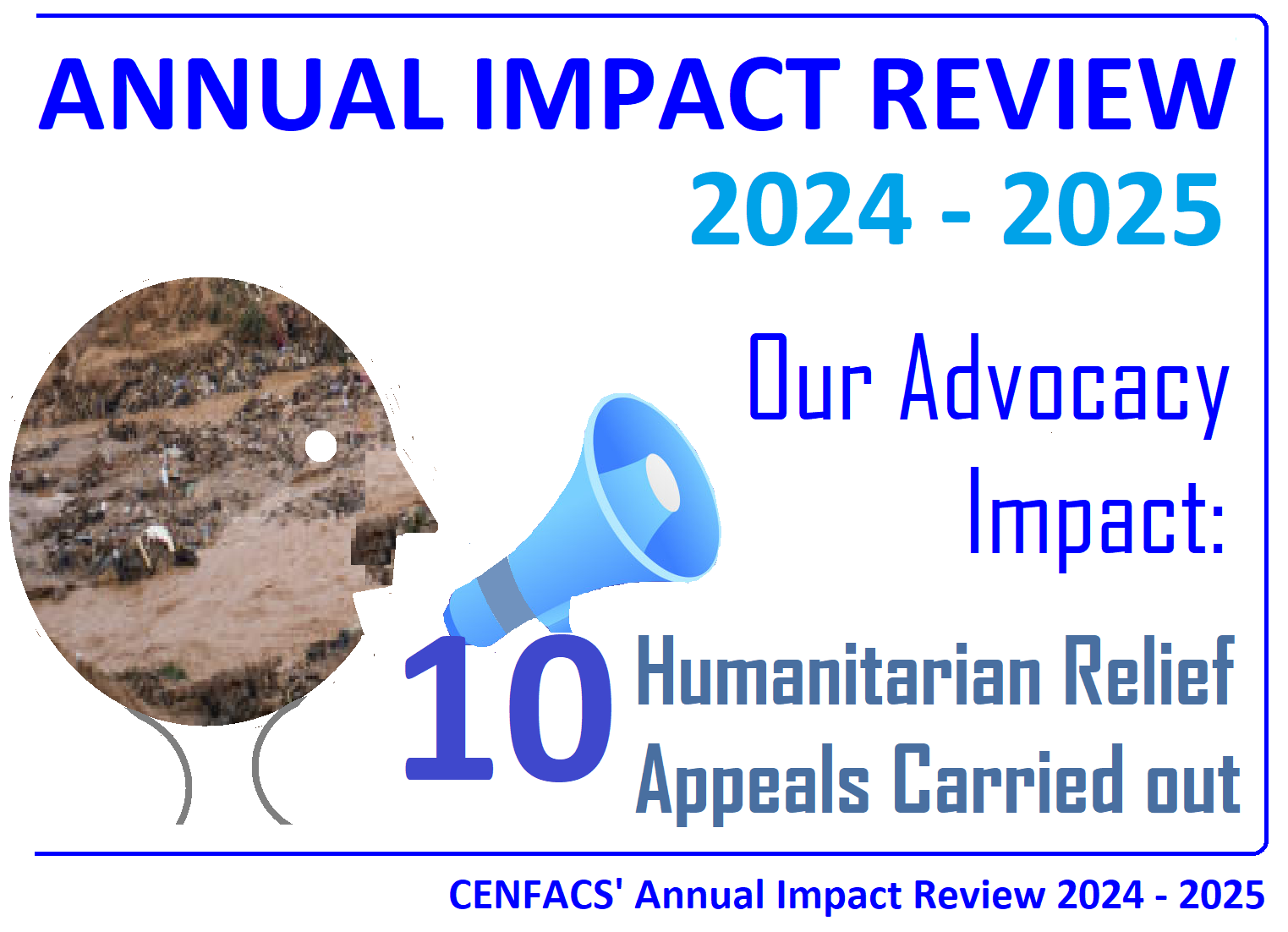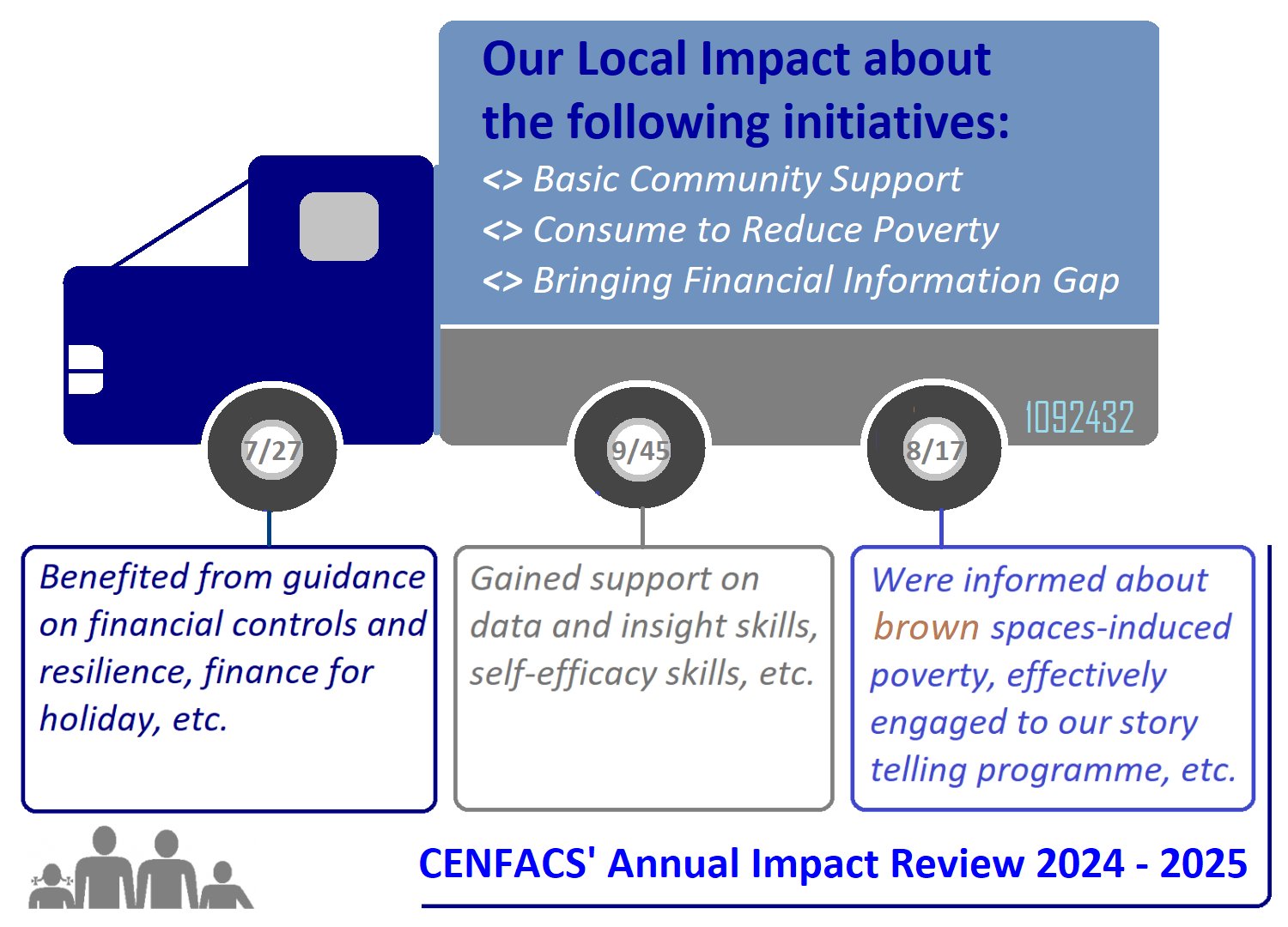Welcome to CENFACS’ Online Diary!
27 August 2025
Post No. 419
The Week’s Contents
• CENFACS Annual Impact Review 2024/2025
• Trend Analysis 2025 Activities from 27/08/2025
• Poverty Reduction Market Trend Analysis
… And much more!
Coming This September 2025:
Key Messages
• CENFACS Annual Impact Review 2024/2025
CENFACS Annual Impact Review 2024/2025 is a snapshot of what we did between 1 July 2024 and 30 June 2025. As it is stated, it is neither a statutory annual report nor an annual return.
It is a summary of the year 2024/2025 in the life of CENFACS that reports back to our supporters, users, project beneficiaries, members, followers and other stakeholders the impact we made; impact through stories, quantitative and qualitative data. The review considers CENFACS impact on its intended beneficiaries while including any unintended effects which may have occurred.
The review highlights accomplishments made and recollects milestones for the above stated year. It uncovers trends and data-driven insights into outcomes and about the changes that affected our noble and beautiful cause of poverty reduction.
It outlines some highlights from our 2024 Year-in-review Report while including our achievements made by the end of June 2025.
It is as well a performance review and annual impact review story of our finances.
It is finally the impact story of moving forward to protect the gains or legacies of our building-forward-better-together work while building upon progress to achieve a more equitable and inclusive society.
For more on this review, please read under the Main Development section of this post.
• Trend Analysis 2025 Activities from 27/08/2025
We are continuing to work on the three types of Trend Analysis 2025 Activities, which are:
a) Trend Analysis for CENFACS as a Charity
b) User Activity Trend Analysis
c) Trend Analysis of the Poverty Reduction Market by following the Direction of Poverty Reduction.
This week, we are working on the fourth focuses of these 2025 Summer trend analysis activities; focuses which are given below.
• • Trend Analysis for CENFACS as a Charity – In Focus from Wednesday 27/08/2025: Operational Efficiency
Operational Efficiency as an element of this week’s trend analysis includes volunteering levels and costs of having them, and technology adoption. Let us briefly analyse them.
• • • Volunteering level and efficiency
CENFACS is a volunteer-based organisation, meaning that it heavily relies on volunteers to deliver its services and mission. Analysing level of volunteers helping CENFACS, their turnover rates and associated costs can help understand how CENFACS optimise volunteering and resource allocation.
• • • Technology adoption
It is about tracking the use of technologies (e.g., CRM, online fundraising platforms) that can help identify areas where CENFACS can leverage technology to improve efficiency and reach. For instance, AI-powered technologies are invading all areas of human life including the charity sector. Checking how CENFACS is approaching these technologies is also a matter of interest as far as operational efficiency is concerned.
• • User Activity Trend Analysis – In Focus from Wednesday 27/08/2025: Increase Product/Service Retention
Perhaps, the best way to start this analysis is to explain product or service retention.
• • • What Is Product/Service Retention
To explain it, let us refer to what ‘shipscience.com’ (1) argues about it, which is:
“Product retention is the practice of maintaining customer loyalty and engagement by keeping them back to use your product or service. It is a key metric that measures how long customers continue to use your product after their initial purchase or subscription”.
Although ‘shipscience.com’ speaks about customers, it is possible to extend this notion to charities and project beneficiaries. By extending it to beneficiaries and service users, service retention will be about ensuring that CENFACS beneficiaries and service users stay with the services provided by CENFACS (e.g., advice, advocacy, translation, etc.) for a long period, at least for the duration of the programme and project they are involved in.
Knowing what is product/service retention, it is possible to explain the increase in product/service retention.
• • Increase Product/Service Retention
The trend analysis of CENFACS‘ increase of service retention will include the study of CENFACS‘ strategies in terms of personalised thank-you messages, communications and data-driven insights, community events, and brand awareness. Let us explain what these strategies mean.
Regarding personalised thank-you messages, we shall check if CENFACS promptly sent these messages to donors after their contributions to show appreciation and to reinforce their support.
Concerning communications, we shall verify if CENFACS regularly kept in touch with donors and funders through various channels to foster relationships, and provide updates on CENFACS‘ progress.
As to data-driven insights, checks will be made to find out if CENFACS uses data to measure and analyse metrics like donations secured per year, number of donors, number of lapsed donors, and average duration of the donor lifecycle to inform retention strategies.
With respect to community events, we shall look at if CENFACS organised or participated in local fundraising events to create a sense of community and connection among donors, which can significantly impact donor loyalty and trust.
As far as brand awareness is concerned, it will be appropriate to analyse whether or not CENFACS has increased its brand awareness by keeping itself top of mind for potential donors and funders, especially during the times of urgent and demanding humanitarian need or the cost-of-living crisis.
If CENFACS did apply these strategies, there would be a lot of chance for it to retain its donors and funders, while building a loyal base of supporters.
• • Trend Analysis of the Poverty Reduction Market by Following the Direction of Poverty Reduction via the Integration of Nature and UNSDGs (United Nations Sustainable Development Goals) – In Focus from 27/08/2025: The Integration of Nature Goal A and UNSDG 15
Let us consider Nature Goal A as given by ‘unep.org’ (2). Nature Goal A is Protect and Restore (that is, Ecosystems will be maintained , enhanced or restored, the extinction rate has been reduced tenfold, and we have an abundance of native wild species on healthy and resilient levels).
UNSDG 15 is Protect, restore and promote sustainable use of terrestrial ecosystems, sustainably manage forests, combat desertification, and halt and reverse land degradation and halt biodiversity loss.
If one considers ecosystems maintenance from Nature Goal A and UNSDG 15, it is possible to integrate ecosystems maintenance and the elements of UNSDG 15. This integration can be approached via the eight links below.
Link 1: Between ecosystems maintenance and protection of terrestrial ecosystems
Healthy ecosystems provide essential ecosystem services, such as clean air, water and food, which are necessary for both environmental health and human well-being. Protecting and restoring ecosystems halt land degradation and biodiversity loss, ensuring that the land can continue to support human activities, industries, and future generations without depleting its natural resources. The maintenance of these natural systems directly enables the protection and sustained use of terrestrial services.
Link 2: Between ecosystems maintenance and restoration of terrestrial ecosystems
Ecosystems maintenance is a continuous effort that enables restoration by preserving the necessary conditions for a functional, self-sustaining ecosystem; while restoration is a targeted intervention to reverse degradation and recover lost functions. Restoration efforts rely on existing maintenance to be successful by establishing foundational processes like nutrient cycling, soil health, and biodiversity, which are themselves dependent on long-term maintenance to persist. So, ecosystems maintenance provides the steady-state environment that restoration aims to rebuild, creating a cyclical relationship where both are vital for conserving terrestrial ecosystems, such as carbon sequestration and water purification.
Link 3: Between ecosystems maintenance and promotion of sustainable use of terrestrial ecosystems
Ecosystems maintenance is the foundation for sustainably using terrestrial ecosystems because it ensures the continued provision of vital ecosystem services, such as clean air and water, food, and climate regulation. By conserving and restoring ecosystems, we maintain their ability to function, which supports biodiversity and protects against land degradation, therefore enabling the long-term, healthy use of land and its resources by humans.
Link 4: Between ecosystems maintenance and sustainable management of forests
Ecosystems maintenance is integral to sustainable forest management, as healthy, functioning ecosystems provide the vital biodiversity, ecological productivity, and resilience that enable forests to thrive and provide benefits for future generations. Sustainable forest management involves a holistic approach to forest use and care, actively maintaining these ecological functions and ensuring the continued supply of ecosystem services, thereby linking the two concepts.
Link 5: Between ecosystems maintenance and combating desertification
Maintaining healthy ecosystems is crucial for combating desertification because healthy ecosystems provide essential services like water retention, soil stability, and biodiversity, which are directly eroded by desertification. By restoring and conserving these natural systems through sustainable land management practices like reforestation and agroforestry, community can reverse land degradation, enhancing ecosystem services and building resilience to drought, thereby preventing and even reversing the process of desertification.
Link 6: Between ecosystems maintenance and halting land degradation
Land degradation harms ecosystems by reducing their ability to provide vital ecosystem services, creating a negative feedback loop that accelerates further degradation. Maintaining ecosystems through practices like sustainable land management is crucial for halting land degradation because healthy ecosystems provide essential services, such as soil stability and water regulation that prevent soil erosion, desertification, and loss of fertility.
Link 7: Between ecosystems maintenance and reversing land degradation
Maintaining ecosystems is essential for reversing land degradation because healthy ecosystems provide the ecological process and services – such as soil ability, water regulation, and nutrient cycling – that prevent and repair land damage. Restoration efforts, focused on ecosystem recovery, directly counter degradation by re-establishing functional ecosystems and improving biodiversity, which in turn creates a positive cycle of land improvement, enhanced ecosystem services, and a stable resource base.
Link 8: Between ecosystems maintenance and halting biodiversity loss
Maintaining ecosystems provides the foundation for biodiversity; diverse ecosystems support a wider variety of species and provide them with the habitats and resources they need to thrive, while diverse species, in turn, contribute to the health, resilience, and stability of ecosystems. Therefore, ecosystems maintenance is a crucial strategy to halt biodiversity loss because it preserves the essential conditions for species survival, while the intrinsic value of biodiversity helps ensure ecosystems to continue providing vital services like clean air, water, and food, which are essential for human health and well-being.
So, it is possible to follow the Direction of Poverty Reduction via the Integration of Nature Goal A and UNSDG 15, via the above-mentioned links. As these links show, Nature Goal A and UNSDG 15 can have joint, even multiple effects on poverty reduction. Therefore, it is feasible to observe or follow the journey of poverty reduction via the integration of Nature Goal A and UNSDG 15, and their joint or multiple effect. To follow with us the direction of poverty reduction via the Integration of Nature and UNSDGs, please contact CENFACS.
For any queries and/or enquiries about the Trend Analysis Month, please do not hesitate to communicate with CENFACS.
• Poverty Reduction Market Trend Analysis
Besides following the direction of poverty reduction via the integration of Integration of Nature and UNSDGs (United Nations Sustainable Development Goals), we are analysing poverty reduction market or simply getting informed from what trend analysts are saying about poverty reduction market trends.
Indeed, poverty reduction has a market where there is a demand and supply; a demand from those who are looking for relief and a supply for those who can meet this sort of demand through their support. If this is the case, what is poverty reduction market? To explain it, let us start with market trend analysis?
• • What Is Market Trend Analysis?
According to ‘explodingtopics.com’ (3),
“Market trend analysis is a systematic approach to evaluating the direction and momentum of market movements over time. It involves examining historical data, current market conditions, and potential future developments to identify patterns that inform business strategies”.
It can also inform charity strategies. Because it can inform charities as well, in particular their work on poverty reduction, what is poverty reduction market?
• • Understanding Poverty Reduction Market
Within the poverty literature, it emerges that a poverty reduction market refers to the economic activities and mechanisms that aim to alleviate poverty by increasing the access of low-income individuals and communities to goods and services, creating economic opportunities, and fostering sustainable livelihoods.
It is possible to analyse the trends relating to this market.
• • Poverty Reduction Market Trend Analysis
This analysis concerns both the UK and Africa markets as they are CENFACS areas of operation.
Concerning the UK market, it emerges from the study by Joseph Rowntree Foundation (4) that economic growth alone will not be sufficient to reduce poverty levels, without additional actions. That poverty and deep poverty are expected to remain broadly flat between late 2024 and the end of 2028, even if the UK has the highest Gross Domestic Product (GDP) per capita growth in the G7 . The same analysis highlights that the importance of addressing the needs of the middle-income group, as their incomes are likely to continue to pull away from those of lower-income groups due to their higher contribution of earnings to their incomes.
According to ‘statistica.com’ (5),
“The UK economy grew by 0.4 percent in May 2025 after shrinking by 0.1 percent in May. Since a huge decline in GDP in April 2020, the UK economy has gradually recovered and is now 4.4 per cent larger than it was before the COVID-19 pandemic”.
Concerning Africa market, the African Development Bank’s 2025 Macroeconomic Performance and Outlook report (6) forecasts an acceleration of Africa’s real GDP growth to 4.1% in 2025, then to 4.4% in 2026, driven by economic reforms, decline inflation, and better fiscal and debt management”.
However, there are studies that show that the current level of Africa’s economic growth will not be enough to lift more people out of poverty there. Therefore, African Charities like CENFACS‘ Africa-based Sister Organisations are forced to look for alternative funding models and business models like social enterprises, charity-private partnerships, etc. In other words, to continue to address the root causes of poverty in Africa, they may try to look for the power of market solutions without loosing their integrity and independence as charities.
For any queries and or enquiries about the above-mentioned trend analysis, please contact CENFACS.
Extra Messages
• The Victims of Escalating Flood Crisis in Africa Need Your Help
• Happiness, Healthiness and Wellness Journal – Creative Activity No. 6: Create Your Journal of Freedom to Choose and Capabilities
• Coming Next Week: Intergenerational Financial Planning for Families
• The Victims of Escalating Flood Crisis in Africa Need Your Help
Climate pressure continues to increase vulnerability in many African countries that experienced torrential rains followed by floods. Among these countries are Mali, Cameroon, the Democratic Republic of Congo, and so on.
According to ‘africacenter.org’ (7),
“Flooding caused by the extensive rainfall impacted roughly 11 million people, resulting
in an estimated:
• 2,500 fatalities
• 4 million people displaced
• Millions of hectares of croplands inundated
• Hundreds of thousands of livestock lost
• Hundreds of healthcare facilities destroyed or damaged
• 10 million children in Niger, Nigeria, the Democratic Republic of the Congo (DRC), and
Mali being unable to attend school as thousands of schools were flooded or converted
into temporary housing for displaced people”.
These numbers can grow as the crisis lasts. These Victims of Escalating Flood Crisis in Africa need safe drinking water, food, sanitation, health and hygiene products. Floods destroyed critical infrastructure like schools, healthcare facilities and agricultural lands.
The Victims of Escalating Flood Crisis in Africa Need Your Help. Your help will
~ enable to acquire flood-resilient infrastructure and advanced early warning technologies
~ provide access to innovations like AI-powered forecasting technologies
~ improve preparedness
~ stop the outbreaks of water borne diseases
~ promote climate smart agriculture
~ train farmers in floor-resilient practices
etc.
Those who wish to support this appeal can donate money and/or donate in kind or their influence.
Please donate or influence immediately as the needs are pressing and urgent NOW.
To support or enquire about this humanitarian appeal, please contact CENFACS.
The Victims of Escalating Flood Crisis in Africa are looking forward to your generous support to make a meaningful difference to their lives.
Thank you for your generosity.
• Happiness, Healthiness and Wellness Journal – Creative Activity No. 6: Create Your Journal of Freedom to Choose and Capabilities
The last episode of our Summer series of Journal of Happiness, Healthiness and Wellness is about Freedom to Choose and Capabilities. It is about writing on the things that have expanded your freedoms (i.e., liberty or independence) and opened more choices for you to find your own development paths according to socially acceptable values rather than being prescribed to follow a particular path. As Armarthya Sen (8) explains in the following words:
“Freedom implies not just to do something but the capabilities to make it happen”.
Yet, personal circumstances and external factors (e.g., extreme temperatures, higher costs of living) have restricted the freedom to choose, incapacitated people, and limited the choice one can make about their happiness, healthiness and wellness over Summer 2025.
Despite these restrictions, limitations and incapabilities; one can create or write a journal of freedom or unfreedom to choose to reflect their conditions and circumstances of life brought by the lingering effects of these circumstances and factors.
Before embarking on writing this journal, it is better to get some clues about the relationships between happiness and freedom, between healthiness and freedom, between wellness and freedom.
Equally, it is better to understand the relationships between happiness and capabilities, between healthiness and capabilities, between wellness and capabilities.
• • Relationships between Happiness and Freedom, between Healthiness and Freedom, between Wellness and Freedom
• • • Relationships between Happiness and Freedom
There could be a link between happiness and freedom. Ruut Veenhoven (9) explains that
“Freedom is the possibility to choose, and involves both the opportunity and capability to choose… Freedom does not always contribute to happiness, but it does not destroy it either. The data strongly suggest that economic freedom leads to happiness, especially for those in conditions of poverty and low capability. The effect that political and private freedom can add to happiness has been restricted to rich and capable countries”.
One can use Veenhoven’s view or other views on the relationship between happiness and freedom to narrate their experiences, feelings, sentiments and thoughts in terms of happiness and freedom over this Summer.
• • • Relationships between Healthiness and Freedom
The pursuit of healthiness can lead to some degree of freedom. For some people, healthiness can facilitate freedom and be dependent on a personal orientation towards freedom. For other ones (like the neo-liberals who value individual responsibility), they blame the health victims. From this blame perspective, De Jong et al. (10) explain that
“Freedom is understood from an individualistic, neoliberal point of view, which is characterised by voluntarily demonstrating individual responsibility, prudence, health consciousness, health commitment and productivity regarding the construction of one’s healthiness”.
One can use the argument of De Jong et al. or other arguments regarding the relationship between healthiness and freedom to write their experiences, feelings, sentiments and thoughts in terms of healthiness and freedom over this Summer.
• • • Relationships between Wellness and Freedom
Let us first explain wellness. Di Martino et al. (11) quotes Prilleltenskj to define wellness in psychology as
“A positive state of affairs brought about by the simultaneous and balanced satisfaction of diverse objective and subjective needs of individuals, relationships, organisations and communities”.
This positive state of affairs can lead to freedom. In return, freedom (e.g., freedom of movement and occupation) can contribute to well-being.
One can use the link between the positive state of affairs and freedom to journal their experiences, feelings, sentiments and thoughts in terms of wellness and freedom over this Summer.
• • Relationships between Happiness and Capabilities, between Healthiness and Capabilities, between Wellness and Capabilities.
Capability can be related to happiness, healthiness and wellness. But, what is capability?
According to ‘cloudassess.com’ (12),
“A capability represents a blend of personal and technical skills, knowledge and behaviours that allow an individual or an organisation to perform effectively. For individuals, it is about the potential to apply skills and knowledge in different situations”.
Armarthya Sen goes further in its capabilities approach by pairing functionings and capabilities. Tom Jacobson and Leanne Chang (13) refer to Sen’s capabilities approach and write this:
“Capabilities refer to real opportunities citizens have to enjoy a functioning rather than to the actual enjoyment of the functioning”.
Still for Jacobson and Chang, Sen believes that development must focus on a range of doings and beings, or functionings, which are much broader than material well-being.
One can refer to the definition of capability by ‘cloudassess.com’ and Sen’s capabilities approach or any other perspective on capabilities, and journal their experiences, feelings, sentiments and thoughts in terms of the relationships between capability and happiness, between capability and healthiness, between capability and wellness over this Summer.
• • Create or Write a Journal of Freedom or Unfreedom to Choose and Capabilities for Any Life Circumstance
To reflect the above-mentioned restrictions or limitations or even incapabilities as well as relationships, one can create or write a journal of freedom or unfreedom for the things that have made them to feel happy, healthy, well, capable and free during this Summer 2025. Alternatively, one can consider journaling the things that have made them unhappy, unhealthy, unwell, incapable and confined this Summer 2025.
Since, the work of CENFACS is on poverty reduction, one can as well think of writing a journal that explains the freedom and ability they have to choose solutions to reduce or end poverty and hardships. Such a journal can include things like being able to choose items within the basic necessities of life (e.g. kinds of food, shelter, education, information, health, etc.).
For example, one can write about fostering their own or people’s competence to make their own choices to exercise their own agency or about the freedom to meet their own needs. One can as well write on deficit in freedom to choose.
You can create your journal for any aspects of Summertime linked to freedom to choose. You can explain your experiences, feelings, sentiments and thoughts in terms of happiness, healthiness and wellness about freedom to choose and capabilities over this Summer.
In short, you can create or write a journal of the following:
∝ Things that have made you to feel happy, healthy, well, free and capable over this Summer 2025
∝ Things that have made you unhappy, unhealthy, unwell, incapable and confined over this Summer 2025
∝ Explaining the freedom and capability you have to choose solutions to reduce or end poverty and hardships over this Summer 2025.
• • Impact Record and Share of Your Journal of Freedom to Choose and Capabilities
You can impact record your thoughts, feelings, sentiments, experiences, souvenirs and memories in relation to happiness, healthiness and wellness regarding the freedom to choose and capabilities. This can be recorded in your journal and be shared by the end of Summer 2025.
To impact share the contents of your journal of happiness, healthiness and wellness relating to happy, healthy, good, capable and free livelihoods during this Summer 2025 as well as to help build a better Summer holiday experience, you can contact CENFACS.
• Coming Next Week: Intergenerational Financial Planning for Families
Eliminating (inter/intra) generational poverty among women and children is the fifth poverty goal of CENFACS’ 2020s Development Agenda and Poverty Reduction Programme (14). To eliminate it, it requires financial planning amongst other things.
In order to implement this goal, we are running a 6-week support for those would like to dive into intergenerational financial planning to help not only to manage and transfer wealth to their future generations, but also to avoid or reduce intergenerational poverty.
Perhaps, the best way of introducing this support is to explain intergenerational financial planning and intergenerational poverty.
• • What Is Intergenerational Poverty?
To understand intergenerational poverty, we have selected the following online definition given by a Commission on Poverty of Hong Kong (15):
“Intergenerational poverty refers to the poverty induced by the socially/economically challenged background of a person’s parents”.
Like any type of poverty, intergenerational poverty has its channels of transmission.
• • What Is Intergenerational Transmission of Poverty?
Briony Smith and Karen Moore (16) point out that
“Intergenerational transmission of poverty can be defined in terms of the type of transmission, the type of poverty, its irreversibility, and the individual/household/contextual factors which enhance or interrupt transmissions” (p. 4)
From the points made by the above named authors, we can now borrow the definition of intergenerational transmission of poverty from Kate Bird and Kate Higgins (17), who argue the following:
“The intergenerational transmission of poverty can be described as the private and public transfer of deficits in assets and resources from one generation to another. Poverty is not transferred intergenerationally as a package; but as a complex set of positive and negative factors that affect an individual’s chance of experiencing in the present or at a future point in their life-course” (p. 9)
In terms of our work with families, we are talking about private intergenerational transfers of these deficits in assets and resources. We are and will be as well working on poverty transmitted from parents to children and grandchildren, but not the one transmitted from young generation to old generation.
To avoid this type of poverty to happen or to reduce its impact if it happens, one needs to set up an intergenerational financial plan.
• • What Is Intergeneration Financial Planning?
According to the website ‘dysifa.com’ (18),
“Intergenerational financial planning is essentially a strategy designed to ensure the smooth transfer of wealth down the generations, in a controlled and tax efficient manner. In essence, it involves integrating financial planning decisions across generations, with grandparents, parents and children all working collaboratively to support each other, while ensuring family wealth is protected and opportunity for growth maximised from one generation to the next”.
The website ‘dysifa.com’ adds that
“An intergenerational approach can ensure the right family members have the right assets at the right time, while minimising any potential for family disputes or conflicts”.
This definition will help to design projects/activities to work with families/households making the CENFACS Community.
• • Working with the Community on Intergenerational Financial Planning
The following topics and dates will be part of our work with the community:
∝ Equipping Children with Financial Literacy (01/09/2025)
∝ Involving Children in Financial Discussions (08/09/2025)
∝ Assessing Family Financial Position (15/09/2025)
∝ Creating a Roadmap for Passing on Wealth (22/09/2025)
∝ Wealth Distribution (29/09/2025)
∝ Strategy for Regular Review of Intergenerational Financial Plan (06/10/2025).
Those who may be interested in Intergenerational Financial Planning or in discussing their Intergenerational Financial Plan, they should not hesitate to contact CENFACS. Equally, those who would like to tackle intergenerational poverty can communicate with CENFACS.
Message in French (Message en français)
• Mises à Jour Financières – Au centre d’intérêt pour l’édition 2025 : Un Journal Financier pour Votre Ménage afin de Réduire la Pauvreté
Comme tout ménage, les ménages formant la communauté CENFACS gagnent des revenus et dépensent leurs revenus. Cependant, lorsque nous avons demandé combien d’entre eux tiennent un journal financier, seulement quelques-uns ont pu répondre. D’autres parmi eux ne savaient même pas ce qu’est un journal financier et si un ménage particulier peut en tenir un.
Dans le but de travailler ensemble avec les ménages qui composent notre communauté, l’édition de cette année des Mises à Jour Financières Estivales (MJFE) se concentrera sur la façon de tenir un journal financier de ménage et de l’utiliser pour mettre à jour les finances des ménages, voire même pour réduire la pauvreté. Mais, qu’est-ce qu’un journal financier pour un ménage?
• • Compréhension de Base d’un Journal Financier pour un Ménage
Il ressort de la littérature financière qu’un journal financier pour un ménage est un enregistrement détaillé de tous les revenus et dépenses, en espèces et non en espèces, sur une période spécifique. C’est un outil utilisé pour suivre les habitudes de dépenses, identifier les domaines où l’argent est dépensé et finalement aider les ménages à gérer leurs finances de manière plus efficace.
Il y a des écrivains qui préfèrent utiliser d’autres terminologies au lieu de journal financier. Par exemple, le site ‘bestegg.com’ (19) parle de journal monétaire. Selon ‘bestegg.com’,
« Un journal financier, également connu sous le nom de journal des dépenses, est un enregistrement de vos dépenses quotidiennes et de vos décisions financières. C’est un compte-rendu détaillé de vos habitudes financières, capturant à la fois les gros et les petits achats effectués chaque jour ».
Le journal financier dont nous parlons ne doit pas être confondu avec les journaux financiers utilisés comme méthode de recherche par les scientifiques sociaux pour étudier comment les ménages gèrent leurs finances, en particulier les personnes ou les ménages à faible revenu ou vulnérables. Cela ne nous empêche pas de nous référer à ce que les scientifiques sociaux avancent au sujet des journaux financiers.
Le journal financier ne se contente pas d’enregistrer les transactions financières quotidiennes. Il peut également être utilisé comme un outil pour réduire la pauvreté.
• • Journal Financier comme Outil de Réduction de la Pauvreté
Le journal financier pour un ménage sera utilisé comme outil pour soutenir les foyers pour aider notre communauté durant cet été 2025 à réduire la pauvreté. En effet, selon ‘korzhykcapital.com’ (20),
“Pour les personnes pauvres, l’argent s’écoule entre leurs doigts comme de l’eau. Elles ne comprennent même pas où va leur argent et en quelles quantités. Elles ne tiennent également aucun registre de leurs économies.”
Cette déclaration de ‘korzhykcapital.com’ peut ne pas être vraie pour tous les pauvres. Cependant, ce qui est vrai, c’est que le journal financier, qui aide à suivre les transactions financières quotidiennes d’un individu ou d’un ménage, peut jouer un rôle crucial dans la réduction de la pauvreté en fournissant des informations précieuses sur les modèles de dépenses, les comportements financiers et l’impact de l’inclusion de cet individu ou ménage.
Ainsi, l’édition de cette année des Mises à Jour Financières ne considère pas seulement le journal financier comme un outil/méthode de comptabilité pour la gestion financière des ménages, mais aussi et principalement comme un moyen de les aider à réduire la pauvreté, car il offre une manière perspicace de comprendre le type de pauvreté que ces ménages rencontrent et de développer des stratégies efficaces pour la réduire.
Pour des informations complémentaires sur l’édition 2025 de MJFE, veuillez contacter le CENFACS.
Main Development
• CENFACS Annual Impact Review 2024/2025
This impact review aims at those who are interested in the work that CENFACS does to get a glimpse of the impact on beneficiaries and what happened during the financial year 2024/2025. It is a summary of our activities, performance, achievements and accounts for the financial year 2024/2025.
The following contents make this review:
∝ Theme of CENFACS’ 2024/2025 Annual Impact Review
∝ Annual Impact Review Summary 2024/2025.
Let us uncover these contents.
• • Theme of CENFACS’ 2024/2025 Annual Impact Review
The theme for this impact review is moving forward to protect the gains or legacies of our Building-forward-better-together work while building upon progress to achieve a more equitable and inclusive society.
Moving forward to protect legacies of our work means that we are taking deliberate actions to safeguard and manage what we have achieved together with all our stakeholders for future generations. Building upon progress made is about using our achievements of this financial year as a starting point to realise further success or develop further initiatives to reduce poverty and enhance sustainable development.
• • Annual Impact Review Summary 2024/2025
The summary of our annual impact review 2024/2025 is presented under the following four headings:
∝ Activities Review
∝ Key Produce or Achievements of the Year
∝ Financial Performance Review
∝ Thank you
Let us review the activities, achievements and financial performance of the year.
• • • Activities Review
• • • • Summary of the Year
We started 2024/2025 financial year by trying to find a better way of working with the communities in the UK and in Africa as we noticed that many of our members had problems linked to the lack of economic opportunities. As a result, together with them we set up strategies to deal with these problems.
As we realised that the majority of Africa-based Sister Organisations (ASOs) working with CENFACS encountered some difficulties in managing their investments, we decided to work with them in order to address these difficulties and their concerns.
While we were working with them, there were crises (or polycrises) and shocks that were raging. In face of these polycrises and shocks, which did not exempted our members and project beneficiaries, we had no choice than to continue to empower households making the CENFACS Community so that they can stay resilient from these polycrises and shocks.
As those who worked with ASOs were getting older including their volunteers/helpers, ASOs raised the issue of finding the means to cover their retirement. Yet, pension assets were/are low or even inexistent for most of ASOs. This suggested that there was a high level of pension poverty amongst our ASOs and their beneficiaries/users. This provided us with a window of opportunities to work with pension fund managers of these ASOs to fill the gap. As a result, 40% of ASOs developed pension schemes and policies to help their employees and beneficiaries.
Since conflicts continued to undermine the existence of poverty and poor people in place like the eastern part of the Democratic Republic of Congo, many of our supporters and organisations working in conflict areas weighed in to call for the analysis of economic factors that contribute to peace and conflict resolution. As a result, we worked with African Charities by looking at the ecosystem of peace economics and how these Charities can approach conflict prevention and resilience in order to reduce poverty due to the lack of economic peace. This is knowing that it is the poor who always bear the brunt of the impact of these conflicts and the lack of economic peace. Among these poor people were the African Displaced Orphans. So, launching an appeal to deal with the fate of these orphans was a life-saving enterprise for them.
One should not forget that these conflicts concern also lands and natural resources. Restoring land became crucial amongst the objectives we set up for 2024/2025, since 2025 has been dedicated as a year of Restoration. Through a new programme of Land Restoration and Drought Resilience proposed by our ASOs, we started to work on this matter with them. However, to restore land and stay resilient to drought require finance or climate finance. Likewise, to reduce poverty it demands finance. Many of African Charities experienced some difficulties to secure finances for climate change and for poverty reduction. To enable them to overcome these difficulties, an integration between climate finance and poverty reduction finance became crucial as a way of negotiating funding.
This integration was even important as international and foreign aid were cut. To keep this integration going and respond to aid cuts we worked together with ASOs on alternative funding strategies via our campaign on Charitable Response to Aid Cuts. As a result, many of these ASOs reviewed their funding and business models to cope with the new reality.
From the above summary, there are many things one can take away in terms of impact.
• • • • Key Takeaways of the Year
The points or facts to remember about 2024/2025 from within and around CENFACS are as follows.
∝) 2024/2025 as a year of building generational investment management capacity and wealth by African Charities
Working with Africa-based Charities enabled them to develop strategies to better manage investment risks by spreading investments across asset classes and industries. It also pushed them to balance returns on investment and concerns on the same investments, while continuing to meet the needs of the poor – their project beneficiaries.
∝) 2024/2025 as a year of reducing pension poverty or old age poverty by African Charities
With general advice clinics we had together with African Charities, this helped them to use pension fund management as a way of accumulating capital to be paid out as pension to their employees and to support their pension fund management strategy. Many of them improved their pension funds administration, pension policies, pension and benefit packages, fund strategy and structure.
∝) 2024/2025 as a year of reducing poverty linked to the lack of economic peace
2024/2025 is also a year of using the principles, recipes and ecosystem of peace economics in order to further help reduce poverty ad enhance sustainable development in CENFACS’ areas of operation in Africa. Together with Africa-based Sister Organisations, we helped in addressing issues leading to conflicts and inequality and enhance social mobility. This work on prevention and resilience contributed to build and cement economic peace in those areas.
∝) 2024/2025 as a year of integrating climate finance and poverty reduction finance
2024/2025 provided a renewed opportunity to engage with African Charities to ensure that funds were channelled towards activities that simultaneously tackle climate change and reduce poverty in Africa receive a fair share or consideration. Our joint work helped them improve their finance strategies regarding both climate and poverty reduction issues.
∝) 2024/2025 as a year of following the direction of poverty reduction via aquatic foods and systems
We followed the direction of poverty reduction via aquatic foods by focussing on four variables as follows: 1) price (affordability of aquatic foods) 2) environment (low-climate impact of aquatic foods) 3) consumption (aquatic food and consumption poverty reduction) and 4) technology/production (low-cost technology to produce aquatic foods).
This follow-up enabled our users to understand how aquatic foods and systems can help reduce poverty.
∝) 2024/2025 as a year of spatial analysis of poverty with the redevelopment of brown spaces
2024/2025 was as well been a year of engaging space to deal with poverty induced or linked to brown space. It was a year of addressing spatialisation of poverty. We explored with poor living in or around brown spaces ways of reducing or ending this type of poverty. Besides that, we made efforts with them to reduce health hazards from brown spaces.
∝) 2024/2025 as a year of advocacy to save critically endangered fish species via Mbisi project
Through the ‘Mbisi‘ project and ‘A la une‘ (Autumn Leaves of Action for the Upkeep of the Nature) campaign, we tirelessly worked with the community and others outside our community to raise awareness of the upkeep of endangered fish species like
Bagrus meridionalis, Treur River barb, Sandfish, Estuarine Pipefish Syngnathus Watermeyeri, Haplochromis granti, Basking Shark, African Wedgefish (Rynchobatus Luebbert) and Barbel spp.
∝) 2024/2025 as a year of Matching Organisation-Investor Programme
We quarterly ran four matching 0rganisation-investor projects which were on the following four areas: farming charitable loan, African art investment, land restoration and telehealth. These projects, which were the matching opportunities of the year 2024/2025, offered to both ASOs and not-for-profit investors a chance to make their dream come true. In other words, there were occasions for ASOs to find the investment they were looking for and not-for-profit investors the organisation to invest in, and both of them could move forward with certainty in their chosen direction.
∝) 2024/2025 as a year of household empowerment
Continuing to empower households making the CENFACS Community is what makes these households strong and links us as a community. During 2024/2025, we relentlessly worked with them through initiatives such as data storytelling and communication skills, economic inclusion programme, financial controls and monitoring, climate-resilient asset building programmes, climate-conscious impact investing strategies, data and insight skills, financial plan updates, etc. All these initiatives placed these households in a better position to reduce poverty and improve the quality of their lives.
∝ 2024/2025 as year of making proposals or ideas for actions for a better Africa
To help reduce poverty in Africa and ensure the public benefit from our work, the following topics were dealt with through CENFACS’ Better Africa Forum:
~ Tomorrow’s Leaders Are Women: What Impact Will Women’s Rise to Public Accountability Be on Poverty Reduction in Africa?
~ Are Energy Transition Minerals the Keys to Poverty Reduction in Africa?
~ Sports World Order and Poverty Reduction in Africa
~ Housing Dilemma in Africa: Housing as a Basic Need for Some versus Housing as Wealth Accumulation for Others
~ Ways of Improving Communication-based Financial Systems to Further Reduce Poverty in Africa
~ Transition from Informal to Formal Economy in Africa
~ Public Transport Subsidy to Reduce Transport Poverty or Poverty Due to Lack of Transport Facilities
~ The Impact of Financial Prosecutor’s Office on Poverty Reduction in Africa
~ Poverty Reduction in Africa in 2025 by African Charities
~ The Economic Role of Charities in Africa
~ Unlocking Africa’s Creative Economy to Further Reduce Poverty, etc.
∝ 2024/2025 as year of making influence work for humanitarian relief in Africa
Making influence support endangered and, in some circumstances, destroyed lives as war and disastrous natural events were unfolding in some places in Africa is another takeaway. Further to these events, together with those stricken by them or their representatives we made the following appeals:
√ End Mpox! as an Influence Appeal for Health Emergency, Prevention, Preparedness and Response to the Monkey Pox Disease
√ The Internally Displaced Persons of Kwilu Need Your Support
√ Rescuing Children Education in Africa
√ Giving Hope to the Humanitarian Needy of Mali in 2025
√ The Internally Displaced Persons of Masisi Want Your Support
√ Halving Poverty for and with the Internally Displaced Orphans in Africa
√ Lighting a Blaze of Hope for Peace, Security and Poverty Reduction for the Conflict Victims of Goma and Its Vicinity in the Democratic Republic of Congo
√ The Double Crisis Impacted Peoples of Kinshasa and Tanganyika Ask for Your Help
√ Orphaned Children in Africa Are Searching for Support: Can You Help?
√ Support Vulnerable Children in Africa Left Without Hope by Foreign Aid Cuts.
With the support of the community in terms of data and stories from these places or areas of CENFACS‘ operation, we made together appeal so that lives and livelihoods could be saved from civil violence, attacks, gender-based violence, aid cuts, severe climate conditions, other life-threatening and destroying conditions (such as the coronavirus, Ebola, Mpox, etc.) and the cost-of-living crisis.
In total, we launched ten humanitarian relief appeals. As a result of these appeals, there have been some support to the sufferers of these events while there is still much to be done.
There are many good and positive results to take away from this financial year, although we limit ourselves to the above key takeaways mentioned.
• • • 2024/2025 Key Produce or Achievements
2024/2025 was a notable year of wins in poverty reduction produce or accomplishments. It will be known as the year of the three key achievements below.
a) 2024/2025 has been a year of wellness as we added wellness to our Summer Projects of Happiness and Healthiness. Wellness – that is, the active pursuit of activities, choices and lifestyles that lead to a state of holistic health, according to the Global Wellness Institute (21) – was the missing piece which many of our users needed and highly demanded in order for them to continue improve the quality of their lives.
b) 2024/2025 could also be remembered as a year land restoration and drought resilience as we responded to the wish of the communities in Africa and worked with Africa-based Sister Charitable Organisations (ASCOs) on restoration projects in areas such as healthy soils, resilient crops, nutritious foods, sustainable land restoration, etc. This was just the beginning of a new programme designed to accompany them in their zero net journey and CENFACS‘ dedicated 2025 year of restoration.
c) 2024/2025 has finally been a year of charitable response to aid cuts in Africa as together with our ASCOs we worked to find new ways to fund poverty reduction and to support ASCOs that were recipient of international aid or service linked to investments which were cut.
The above are just the few selected accomplishments or produce we wanted to share with our audiences and supporters in this annual-impact-review campaign. However, for those who would like get more insights into them and other achievements of the year 2024/2025, they can let us know.
• • • Financial Performance Review
The following is the summary of our receipts and payments for the year ending 30 June 2025.
On the payments side, the lingering effects of the costs of living continued. As result of these effects, our costs increased except for volunteers, IT (Information Technologies) consumables, and transport and travel accounts. We used cheap means of travelling, saved the environment by recycling our cartridges and covered very reasonable expenses for volunteers.
Four accounts (that is, stationery and books, refreshments, IT subscription, and utilities) displayed a huge increase.
Concerning the stationery and books accounts, we had an increase of almost 156%. Indeed, to respond to users’ preferences and technological changes, we had to maintain a relatively adequate level of stationery stock. This enabled us to prevent items running out of stock. We needed to keep a balance between paper and paperless work by having enough stationery to meet the needs of our community where paper is involved. Also, since the COVID-19 years (between 2019 and 2023) our stock of stationery and books went dramatically low, whereas there is still a minimum of stationery that is required to function as an organisation.
Regarding refreshments, high temperatures we are all witnessing require drinking a lot of water and consuming fluid foods to refresh ourselves and continue work. As result, there has been a jump in refreshment account for almost 600% to mitigate the impact of climate change on volunteers’ health.
As to our IT subscription, the charge of web hosting service and broadband was increased; meaning that our IT subscription could not stay the same. There was an increase of 15% in their costs, reflecting the current ascending trends of prices of services of this kind. Likewise, the price of office space and utilities whether working from commercial premises or from home has also increased to almost 14%. There were as well accounts that showed a modest increase like tele/mobile phone and internet (1.9%).
Besides these increases, we also registered some decreases, like our postage accounts went down to almost 10% as we were continuing to communicate via emails and postage rates kept increasing. Another decrease came from the office miscellaneous items as we spent a reasonable amount to meet office administration needs following the savings we made in the previous years on this account. These office miscellaneous expenses were meant to cover ourselves against the uncertainty in the economy. The other accounts that experienced decrease were printing and photocopy (-20%).
On the fundraising and receipts side, the challenge to raise the funds needed to meet the level of needs in the community remained. This could be partly explained by the cumulative effect of the lingering impacts of the cost-of-living crisis and the economic uncertainty which continued to drive hesitations or reluctance to many individual donors/funders. One should not also forget the cuts in international aid which had an indirect effect on the way people support good causes in Africa.
We have to admit that we have still funding applications which we have not yet received replies from potential donors/funders/grant makers. This means there is a reason to believe that there is still a possibility for positive replies from them or to generate funds.
Concerning the cash funds account, our cash funds kept their ascending trends. During the financial year 2024/2025, we registered an increase of almost 71%. In accounting terms, it means that we managed to increase our receipts over payments as our receipts nearly underscored an increase of 71%.
We continued to make savings on overseas budget, volunteer costs, publicity and advertising, translation, office equipment and furniture, project beneficiaries, research and development, and fundraising costs. This increase and savings made on payments resulted in a positive net balance from our receipts and payments account for the year.
We hope that the rebound of our cash funds will steadily continue and be even noticeable in the financial year 2025/2026. We can as well expect that the fruits of our fundraising efforts relating to alternative funding models and of our new business models will fully appear in the new financial year (2025/2026) and beyond.
• • • Thank you
The work of CENFACS is a collective endeavour that relies upon the voluntary contribution of others, a key to our success. As such, there is a number of people and organisations who contributed to the realisation of our financial year 2024-2025.
We would like to indiscriminately acknowledge them. Without their helpful and altruistic support, we would not be able to achieve the above. We are grateful to our volunteers, users, project/programme beneficiaries, members, website/blog readers and supporters.
We would like to thank all of them for their unwavering commitment and impactful support for helping us to voice and bring once again our poverty reduction message into the world in development, especially at the very daunting time of the lingering effects of the polycrises.
Many thanks for making 2024-2025 another deservingly memorable year at CENFACS and for being there with us for those in need.
More details about CENFACS Annual Impact Review 2024/2025 can be requested.
_________
• References
(1) https://www.shipscience.com/what-is-product-retention-a-comprehensive-guide/ (accessed in August 2025)
(2) https://www.unep.org/interactives/biodiversity-sdgs-tool/the-biodiversity-plan/goals/a.html (accessed in August 2025)
(3) https://explodingtopics.com/blog/market-trend-analysis (accessed in August 2025)
(4) https://www.jrf.org.uk/work/economic-growth-and-poverty (accessed in August 2025)
(5) https://www.statistica.com/statistics/941233/monthly-gap-growth-uk/#:~:text=… (accessed in August 2025),
(6) https://www.afdb.org/sites/default/files/aeo_2025_-_ppt_-_presentation_-_27.05.2027_final.pdf (accessed in August 2025)
(7) https://africacenter.org/wp-content/uploads/2025/01/Flooding-in-Africa.pdf (accessed in August 2025)
(8) https://asiancenturyinstitute.com/development/333-armartya-sen-on-deveptas-freedom (accessed in August 2023)
(9) Veenhoven, R. (2000). Freedom and happiness. A comparative study in forty-four nations in the early 1990s. In E. Diener & E. M. Such (Eds.), culture and subjective well-being (pp. 257-288). The MIT Press
(10) De Jong, M., Collins, A. & Plüg (2019), “To be free”: how discourses of freedom are used to constraint healthiness among young South African adults, in International Journal of Qualitative Studies on Health and Well-being 2019, Vol. 14, 1603518, available at https://doi.org/10.1080/17482631.2019.1603518 (accessed in August 2024)
(11) Di Martino, S., Scarpa, M.P. & Prilleltensky, I. (2022). Between wellness and fairness: The mediating role of autonomous human choice and social capital in OECD countries. Journal of Community Psychology, 50, 3156-3180. 10.1002/jcop. 22822, available at https://www.ncbi.nim.nih.gov/pmc/articles/PMC9544613/ (accessed in August 2024)
(12) https://cloudassess.com/blog/skill-vs-capability-vs-competency (accessed in August 2024)
(13) Jacobson, T. & Chang, L. (2019), Sen’s Capabilities Approach and the Measurement of Communication Outcomes in Journal of Information Policy. 9:111-131, available at https://doi.org/10.5325/jinfopoli.9.2019.0111 (accessed in August 2024)
(14) cenfacs.org.uk/2020/03/11/the-2020s-agenda-and-programme/ (accessed in August 2025)
(15) https://www.povertyrelief,gov.hk/archive/2007/en/pdf/TFCYPaper4_2005E.pdf
(16) https://www.files.ethz.ch/isn/128111/WP59_Smith_Moore.pdf
(17) Kate Bird & Kate Higgins (2011), Stopping the intergenerational transmission of poverty: research highlights and policy recommendations, Working Paper No. 214, Chronic Poverty Research Centre (www.chronicpoverty.org), https://assets.publising.service.gov.uk/media/57a08ae6e5274a27b2000827/WP214.pdf
(18) https://dysifa.com/wp-content/uploads/2024/11/An-Introduction-to-Intergenerational-Planning.pdf (accessed in August 2025)
(19) https://www.bestegg.com/blog/what-is-money-diary-and-how-to-keep-one-to-improve-your-finances/ (accessed in August 2025)
(20) https://korzhykcapital.com/article/why_you_should_keep_a_financial_diary (accessed in August 2025)
(21) https://globalwellnessinstitute.org/what-is-wellness/ (accessed in July 2024)
_________
• Help CENFACS Keep the Poverty Relief Work Going This Year
We do our work on a very small budget and on a voluntary basis. Making a donation will show us you value our work and support CENFACS’ work, which is currently offered as a free service.
One could also consider a recurring donation to CENFACS in the future.
Additionally, we would like to inform you that planned gifting is always an option for giving at CENFACS. Likewise, CENFACS accepts matching gifts from companies running a gift-matching programme.
Donate to support CENFACS!
FOR ONLY £1, YOU CAN SUPPORT CENFACS AND CENFACS’ NOBLE AND BEAUTIFUL CAUSES OF POVERTY REDUCTION.
JUST GO TO: Support Causes – (cenfacs.org.uk)
Thank you for visiting CENFACS website and reading this post.
Thank you as well to those who made or make comments about our weekly posts.
We look forward to receiving your regular visits and continuing support until the end of 2025 and beyond.
With many thanks.
